
4.4 Banking and the Expansion of the Money Supply
6 min read•september 22, 2020
Jeanne Stansak
Jeanne Stansak
Banks are financial institutions that accept deposits and make loans. They also serve as intermediary bodies that help the Federal Reserve control the money supply. In our banks, we use a system known as .
Fractional Reserve Banking
is the practice by which a bank accepts deposits and is required to hold only a fraction of its deposits in . The amount that the bank has to keep as is determined by the reserve ratio (i.e. reserve requirement) that is set by the Federal Reserve. This allows the bank to loan out the remainder of the deposit to borrowers. By loaning out this money the bank creates "new" money in the economy. There are several terms involved in the process of .
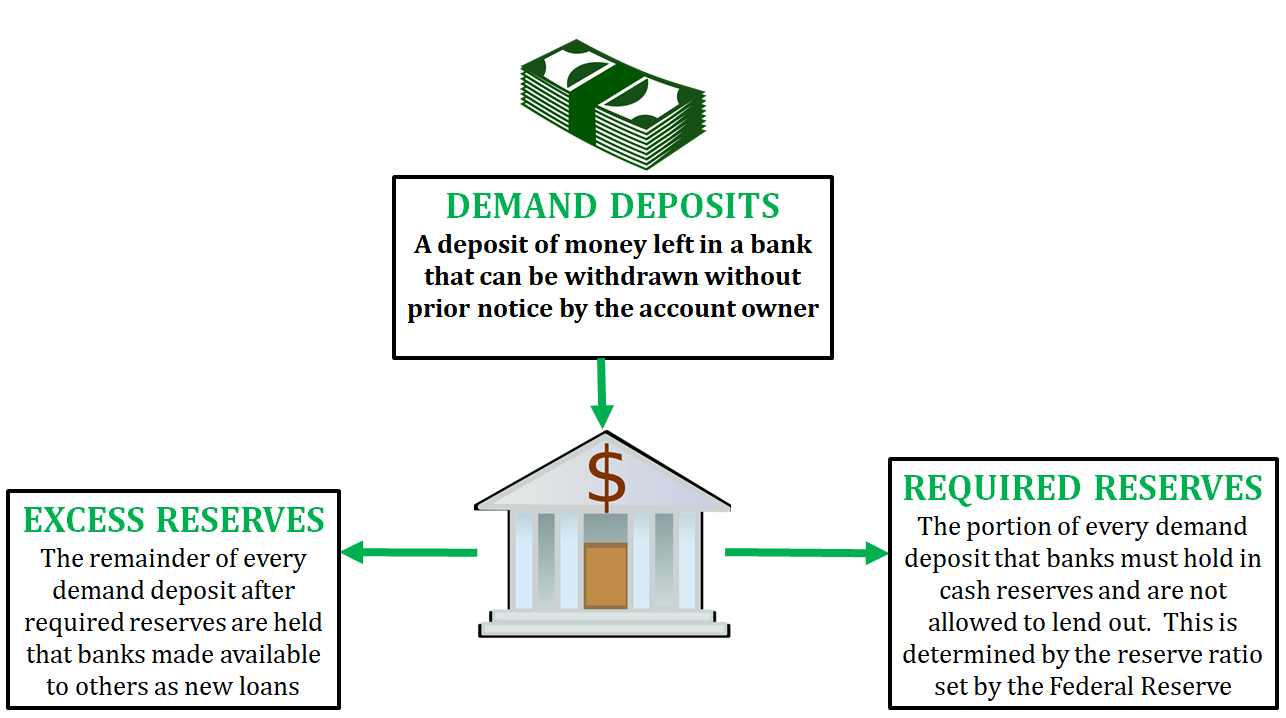
Let's look at how operates. In the table below you will see various amounts of and a designated reserve ratio. Using that reserve ratio (i.e. reserve requirement), we are able to determine how much needs to be kept in reserves and how much is that a bank can loan out.
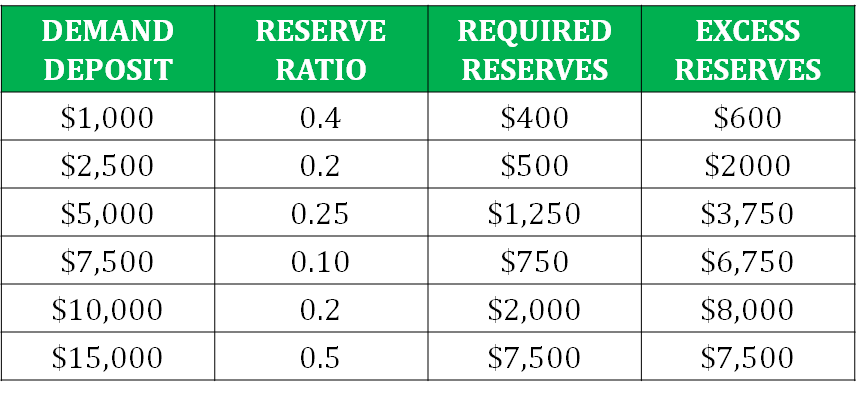
Money Multiplier
When are made, the banks have a portion of that are created by the system. These become new loans and set off a chain reaction of money creation throughout the entire economy. To see how much money is created through this process, we use what is called the .
The is the amount of money that banks generate with each dollar of . The formula for the is calculated by dividing the number 1 by the reserve ratio (i.e. reserve requirement).
So, if the reserve ratio (i.e. reserve requirement) is 0.2, the is 1/0.2, which equals 5. When we take the and multiply by the amount of money that goes out through new loans, we are able to determine how much is added to the money supply. So if $8,000 is in , the bank loans out all this money, and the is 5, we have $40,000 added to the money supply ($8,000 x 5 = $40,000).
If the reserve ratio (i.e. reserve requirement) is higher, the is weaker, and there will be less change to the money supply. If the reserve ratio (i.e. reserve requirement) is lower, the is stronger, and there will be more change to the money supply.
When we are using this process, there are several concepts we are asked to calculate. Typically, when we are given an amount of a demand deposit, the first thing we calculate is how much of this demand deposit is , and then we calculate the . Once we have the number of , we can calculate the change in the money supply.
Let's look at two different examples with the same amount of a demand deposit but different reserve ratios (i.e. reserve requirement).
Example One: For this example, the reserve ratio (i.e. reserve requirement) is 20% or 0.2, which makes the 5 (1/0.2).
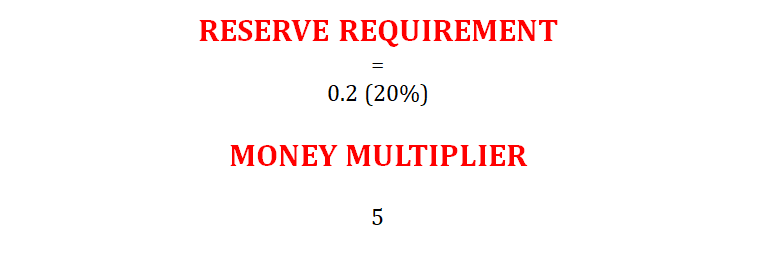
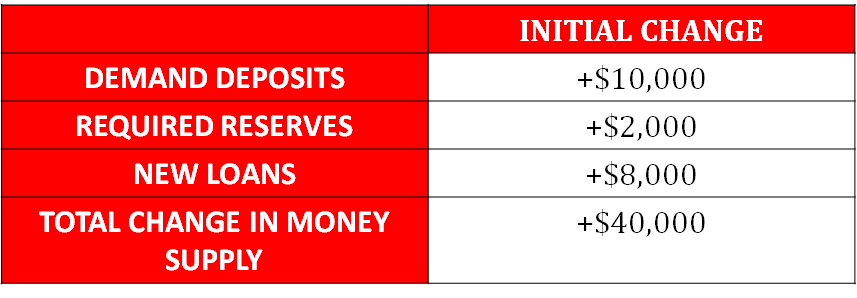
Example Two: For this example, the reserve ratio (i.e. reserve requirement) is 50% or 0.5, which makes the 2 (1/0.5).
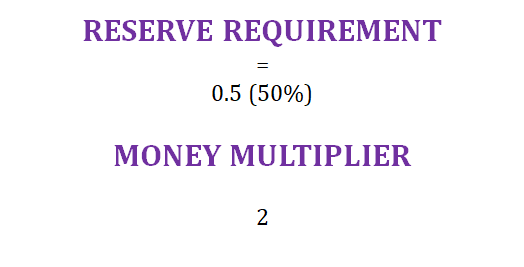
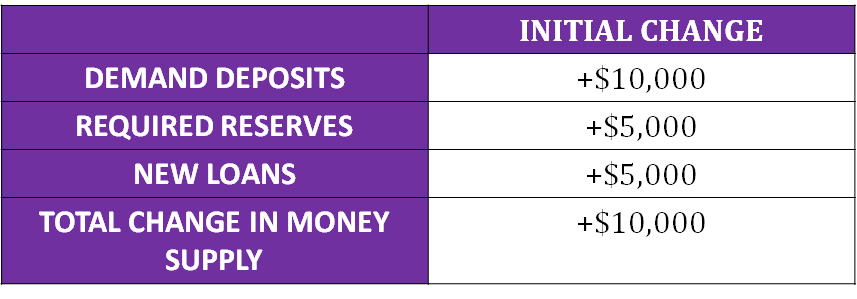
From these two examples, we can see that the money supply changes more when the reserve ratio (i.e. reserve requirement) is lower than when it is higher.
The can also be used to determine the total change in , new loans, and throughout the entire banking system. To find the maximum change in any of these terms, we simply multiply the initial change by the . Look at the table below to see some examples using a reserve requirement of 0.5 and a of 2.
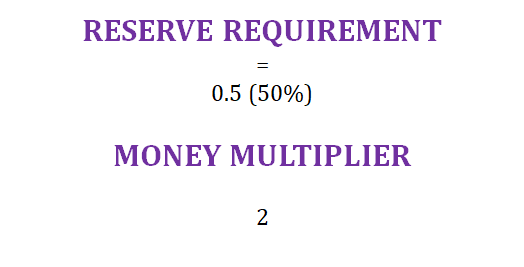

Bank Balance Sheets
(i.e. ) are a visual record of the within a bank. These ledgers show the assets and liabilities within a bank. They can show how a bank uses any deposits and available funds to create reserves and new loans for the purpose of lending. They are called because the liabilities and assets must be equal to each other.
In the banking industry, liabilities are the financial obligations that a bank must pay to a consumer, and they must be repaid when requested. Liabilities include , account investments, and equity. Assets are the possessions that are owned by or credited to a bank that can be collected or liquefied into cash. Assets include both required and , outstanding loans, and securities.Here is a sample bank balance sheet for the Second National Bank that has a reserve ratio of 10% or 0.1. This means that the will be 10. We are going to assume that they will loan out all of their .
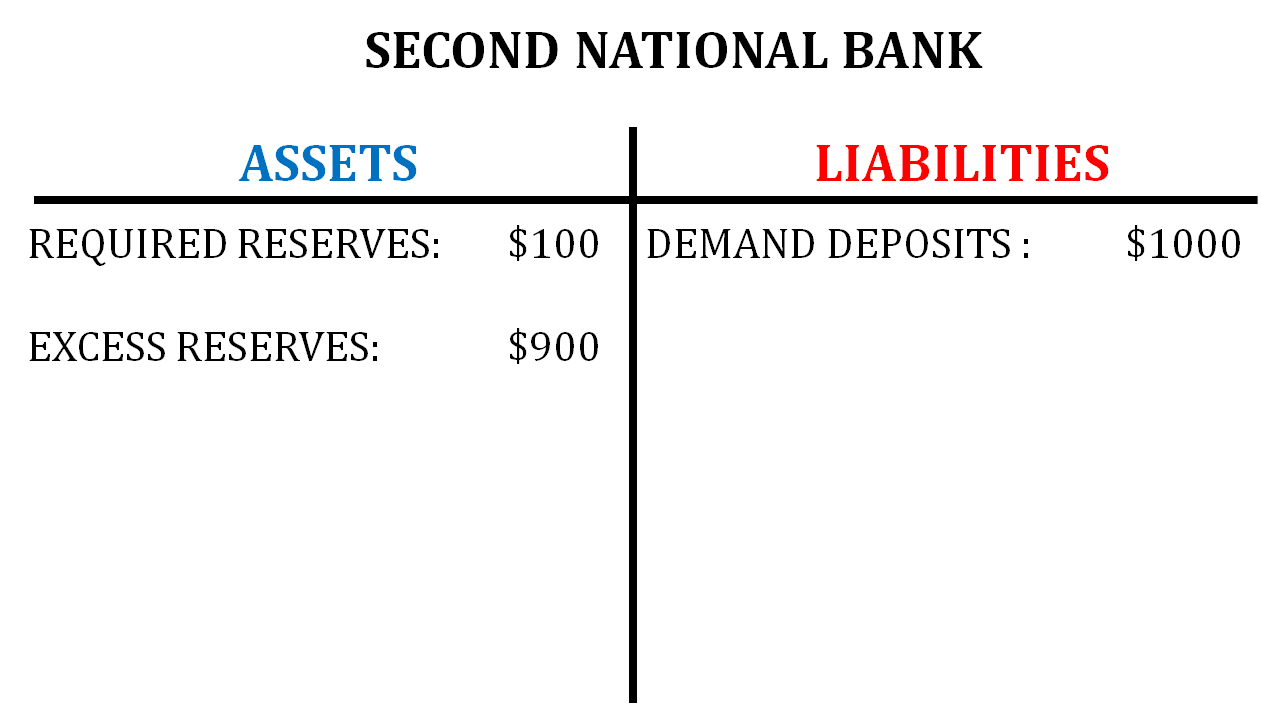
You can see that this particular bank received a demand deposit of $1000, so 10% of that deposit has to be kept as . In this case, the are $100. That leaves $900 of the demand deposit that is considered and can be loaned out. Since we said that the bank will loan out all of their , we know that $900 will go out into the money supply and will create a maximum change in the money supply of $9,000 ($900 x 10).
Practice Free Response Question (FRQ) - 2016 # 2

The bank balance sheet above is for the First Superior Bank.
Assume that the required reserve ratio is 10 percent.
- (a) What is the dollar value of new loans that First Superior Bank can make? Explain.
- (b) Mr. Smith deposits $100 of cash in a demand deposit account in First Superior Bank. Calculate the maximum amount of new loans that First Superior Bank can now make.
(c) As a result of Mr. Smith's $100 cash deposit, calculate the maximum change over time in each of the following in the banking system.
- (i) Loans
- (ii)
- (d) As a result of Mr. Smith's $100 cash deposit, calculate the maximum change over time in the money supply.
- (e) Provide one reason why the actual change in the money supply can be smaller than the maximum change you identified in part (d).
Answers
a)
The amount of new loans is zero because the bank has no because the bank has loaned all the out.
b) The maximum amount of new loans that can be made are $90 ($10 will be the because that is 10% of 100 and $90 will go into and be loaned out)
c)
i. The maximum change over time in loans in the banking system is $900 ($90 x 10 (which is the )) ii. The maximum change over time in in the banking system is $1000 ($100 x 10 (which is the ))
d) The maximum change over time in the money supply is $900 ($90 x 10)
e) the money supply can be smaller than the maximum change identified in part d when the public holds more money and/or banks hold more .
Key Terms to Review (8)
Bank Balance Sheets
: Bank balance sheets provide a snapshot view of a bank's financial position at a specific point in time. They show assets (such as loans and investments) on one side and liabilities (such as customer deposits) and capital on the other side.Cash Reserves
: Cash reserves refer to the amount of money that a bank holds in physical currency or deposits with the central bank, which is not lent out or invested.Demand Deposits
: Demand deposits refer to funds held in a bank account that can be withdrawn at any time without prior notice. These accounts are typically used for everyday transactions and do not earn interest.Excess Reserves
: Excess reserves are funds held by banks that exceed their required reserve ratio, which is the minimum amount they must keep on hand based on customer deposits.Fractional Reserve Banking
: Fractional reserve banking is a system where banks are required to keep only a fraction of their deposits as reserves and can lend out the rest.Money Multiplier
: The money multiplier is the factor by which an initial deposit in a bank can increase the total money supply through the process of fractional reserve banking.Required Reserves
: Required reserves are the minimum amount of funds that banks must hold in reserve against their customers' deposits. These reserves are set by central banks to ensure stability in the banking system and control inflation.T-Accounts
: T-Accounts are a visual representation of accounting transactions that show the flow of debits and credits. They are called "T-Accounts" because they resemble the letter "T", with debits on the left side and credits on the right side.4.4 Banking and the Expansion of the Money Supply
6 min read•september 22, 2020
Jeanne Stansak
Jeanne Stansak
Banks are financial institutions that accept deposits and make loans. They also serve as intermediary bodies that help the Federal Reserve control the money supply. In our banks, we use a system known as .
Fractional Reserve Banking
is the practice by which a bank accepts deposits and is required to hold only a fraction of its deposits in . The amount that the bank has to keep as is determined by the reserve ratio (i.e. reserve requirement) that is set by the Federal Reserve. This allows the bank to loan out the remainder of the deposit to borrowers. By loaning out this money the bank creates "new" money in the economy. There are several terms involved in the process of .

Let's look at how operates. In the table below you will see various amounts of and a designated reserve ratio. Using that reserve ratio (i.e. reserve requirement), we are able to determine how much needs to be kept in reserves and how much is that a bank can loan out.

Money Multiplier
When are made, the banks have a portion of that are created by the system. These become new loans and set off a chain reaction of money creation throughout the entire economy. To see how much money is created through this process, we use what is called the .
The is the amount of money that banks generate with each dollar of . The formula for the is calculated by dividing the number 1 by the reserve ratio (i.e. reserve requirement).
So, if the reserve ratio (i.e. reserve requirement) is 0.2, the is 1/0.2, which equals 5. When we take the and multiply by the amount of money that goes out through new loans, we are able to determine how much is added to the money supply. So if $8,000 is in , the bank loans out all this money, and the is 5, we have $40,000 added to the money supply ($8,000 x 5 = $40,000).
If the reserve ratio (i.e. reserve requirement) is higher, the is weaker, and there will be less change to the money supply. If the reserve ratio (i.e. reserve requirement) is lower, the is stronger, and there will be more change to the money supply.
When we are using this process, there are several concepts we are asked to calculate. Typically, when we are given an amount of a demand deposit, the first thing we calculate is how much of this demand deposit is , and then we calculate the . Once we have the number of , we can calculate the change in the money supply.
Let's look at two different examples with the same amount of a demand deposit but different reserve ratios (i.e. reserve requirement).
Example One: For this example, the reserve ratio (i.e. reserve requirement) is 20% or 0.2, which makes the 5 (1/0.2).


Example Two: For this example, the reserve ratio (i.e. reserve requirement) is 50% or 0.5, which makes the 2 (1/0.5).


From these two examples, we can see that the money supply changes more when the reserve ratio (i.e. reserve requirement) is lower than when it is higher.
The can also be used to determine the total change in , new loans, and throughout the entire banking system. To find the maximum change in any of these terms, we simply multiply the initial change by the . Look at the table below to see some examples using a reserve requirement of 0.5 and a of 2.


Bank Balance Sheets
(i.e. ) are a visual record of the within a bank. These ledgers show the assets and liabilities within a bank. They can show how a bank uses any deposits and available funds to create reserves and new loans for the purpose of lending. They are called because the liabilities and assets must be equal to each other.
In the banking industry, liabilities are the financial obligations that a bank must pay to a consumer, and they must be repaid when requested. Liabilities include , account investments, and equity. Assets are the possessions that are owned by or credited to a bank that can be collected or liquefied into cash. Assets include both required and , outstanding loans, and securities.Here is a sample bank balance sheet for the Second National Bank that has a reserve ratio of 10% or 0.1. This means that the will be 10. We are going to assume that they will loan out all of their .

You can see that this particular bank received a demand deposit of $1000, so 10% of that deposit has to be kept as . In this case, the are $100. That leaves $900 of the demand deposit that is considered and can be loaned out. Since we said that the bank will loan out all of their , we know that $900 will go out into the money supply and will create a maximum change in the money supply of $9,000 ($900 x 10).
Practice Free Response Question (FRQ) - 2016 # 2

The bank balance sheet above is for the First Superior Bank.
Assume that the required reserve ratio is 10 percent.
- (a) What is the dollar value of new loans that First Superior Bank can make? Explain.
- (b) Mr. Smith deposits $100 of cash in a demand deposit account in First Superior Bank. Calculate the maximum amount of new loans that First Superior Bank can now make.
(c) As a result of Mr. Smith's $100 cash deposit, calculate the maximum change over time in each of the following in the banking system.
- (i) Loans
- (ii)
- (d) As a result of Mr. Smith's $100 cash deposit, calculate the maximum change over time in the money supply.
- (e) Provide one reason why the actual change in the money supply can be smaller than the maximum change you identified in part (d).
Answers
a)
The amount of new loans is zero because the bank has no because the bank has loaned all the out.
b) The maximum amount of new loans that can be made are $90 ($10 will be the because that is 10% of 100 and $90 will go into and be loaned out)
c)
i. The maximum change over time in loans in the banking system is $900 ($90 x 10 (which is the )) ii. The maximum change over time in in the banking system is $1000 ($100 x 10 (which is the ))
d) The maximum change over time in the money supply is $900 ($90 x 10)
e) the money supply can be smaller than the maximum change identified in part d when the public holds more money and/or banks hold more .
Key Terms to Review (8)
Bank Balance Sheets
: Bank balance sheets provide a snapshot view of a bank's financial position at a specific point in time. They show assets (such as loans and investments) on one side and liabilities (such as customer deposits) and capital on the other side.Cash Reserves
: Cash reserves refer to the amount of money that a bank holds in physical currency or deposits with the central bank, which is not lent out or invested.Demand Deposits
: Demand deposits refer to funds held in a bank account that can be withdrawn at any time without prior notice. These accounts are typically used for everyday transactions and do not earn interest.Excess Reserves
: Excess reserves are funds held by banks that exceed their required reserve ratio, which is the minimum amount they must keep on hand based on customer deposits.Fractional Reserve Banking
: Fractional reserve banking is a system where banks are required to keep only a fraction of their deposits as reserves and can lend out the rest.Money Multiplier
: The money multiplier is the factor by which an initial deposit in a bank can increase the total money supply through the process of fractional reserve banking.Required Reserves
: Required reserves are the minimum amount of funds that banks must hold in reserve against their customers' deposits. These reserves are set by central banks to ensure stability in the banking system and control inflation.T-Accounts
: T-Accounts are a visual representation of accounting transactions that show the flow of debits and credits. They are called "T-Accounts" because they resemble the letter "T", with debits on the left side and credits on the right side.
Resources
© 2024 Fiveable Inc. All rights reserved.
AP® and SAT® are trademarks registered by the College Board, which is not affiliated with, and does not endorse this website.